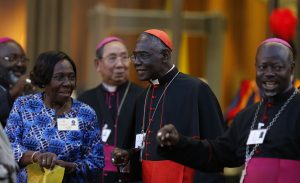ROME – Phil Graham, the legendary publisher of the Washington Post, popularized the phrase that journalism is “the first rough draft of history.” What’s less well remembered is the rest of his quote: Reporters, Graham said, provide a first draft “that will never really be completed, about a world we can never really understand.”
The reference comes to mind in connection with news that Pope Francis has ordered a visitation of the Vatican’s Congregation for Divine Worship and the Discipline of the Sacraments, its department for liturgical policy, less than a month after accepting the resignation of Guinean Cardinal Robert Sarah as prefect. In part, the purpose of the visitation, which has been described as non-punitive, is said to be to inform the pope’s decision about who should take over.
For the record, Pope Francis has not employed a similar system prior to filling other important Vatican jobs, such as the Congregation for the Evangelization of Peoples with Filipino Cardinal Luis Antonio Tagle in 2019 or the Congregation for the Causes of Saints with Italian Cardinal Marcello Semeraro in 2020.
The visitation also comes just days after the Vatican’s Secretariat of State issued a decree eliminating private Masses, meaning a priest saying Mass alone, in St. Peter’s Basilica, and limiting the celebration of Masses in the pre-Vatican II Latin rite in the basilica to one chapel four times a day, all between 7:00 and 9:00 a.m.
Those talking points will endure when history has the last word, but what sense to make of them, at least for now, falls into the “we can never really understand” category.
Are these moves basically benign acts of routine administration, reflecting a pope who knows he’s got some important choices to make in a field – liturgy – which, admittedly, isn’t exactly in his wheelhouse?
Or is this a politically unforgiving pontiff and his Vatican team looking to settle scores and to impose their will in an area which, at times, has been resistant to Francis’s agenda over the last eight years?

The facts would seem to support either interpretation.
Here’s the case for the “nothing to see here” view.
On Sarah: The cardinal turned 75 in June, which marks the age at which bishops are required to submit their resignations, and he’d held his post more than six years, which is a decent run by Vatican standards. (The last 10 prefects of Divine Worship averaged four years on the job.) Moreover, if anyone worked himself out of a job over that span, it was Sarah, from issuing a restrictive interpretation of a decree empowering bishops’ conferences to oversee liturgical translation that had to be disowned by the pope himself, to an embarrassing contretemps about a book initially billed as “co-authored” with Pope emeritus Benedict XVI. In context, one can argue Francis was remarkably restrained.
On Masses in St. Peter’s: Many liturgical traditionalists have taken the ban on private Masses as a rebuke, but that’s not the only way of seeing it. Pope Francis may simply see the celebration of private Mass, especially in the Covid era when people have limited access to the liturgy, as a form of clericalism, regardless of the rite being used. The restriction of the pre-Vatican II Mass to a single chapel could be merely an organizational detail, if the assumption is that other chapels now will be used for limited public celebrations in the new rite.
Visitation: Pope Francis would be the first to admit that he’s not Benedict XVI, for whom the liturgy is a matter of abiding personal intellectual and spiritual passion. As a result, he may feel that he needs more background and someone else’s eyes to choose the right leader for this department, which he didn’t, say, for the Vatican’s primary missionary department with Tagle.
And the more cynical reading?
Sarah: The resignation merely made official what had already been clear, which is that Francis and Sarah weren’t in sync and the pope had worked around, rather than through, his office for some time. His departure completes a slow-motion ideological purge that included the 2017 departure of Italian Cardinal Mauro Piacenza from the Congregation for Clergy in 2013, Polish Cardinal Zenon Grocholewski from the Congregation for Catholic Education in 2015 and German Cardinal Gerhard Müller from the Congregation for the Doctrine of the Faith in 2017.
Masses: It’s hard not to read the order restricting the celebration of the pre-Vatican II Mass to one chapel as a way of underlining that it’s not encouraged or advocated, merely tolerated. The elimination of private Masses also could have a slight political edge, since it’s the sort of exercise, especially in St. Peter’s Basilica, which often appeals to clergy of a more conservative bent.
Visitation: Here’s where it really gets interesting. Suppose the pope already knows who he wants to take over at the Congregation for Worship, or at least has a profile in mind, but wants to know who on the staff might get in the new boss’s way. In other words, he wants to know who the Blues and the Grays are before he sends in a new general. That might explain the unusual choice for a visitation — and, of course, the mere fact of staging one could also be a message to staff that whoever takes over, recalcitrance or outright obstruction won’t be overlooked.
As we said, right now both interpretations, on all three points, can be supported by appeal to the record as it stands. Only what happens from this point on will sway interpretations.
In the meantime, we have to acknowledge that the Vatican may not be the setting Phil Graham had in mind when he described a world “we can never really understand,” but right now, when it comes to the pope and liturgy, the shoe does seem to fit.

